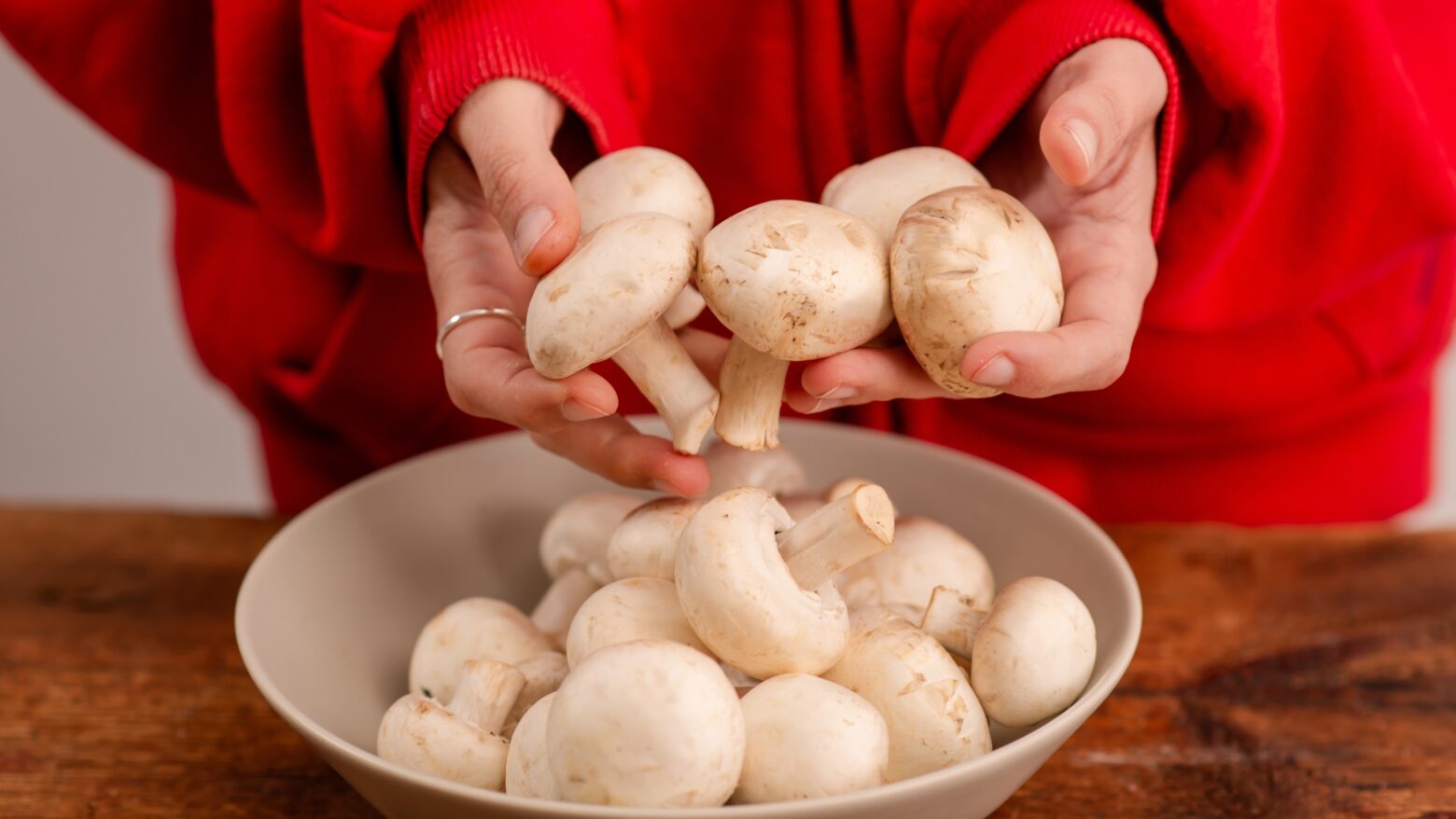Are Mushrooms Healthy? Culinary Tips and Health Benefits of Mushrooms

Those unassuming white mushrooms you often find nestled in the produce aisle are hiding a secret: they’re packed with nutrients you might not expect. Beyond being low in calories, they offer a surprising array of potential health benefits, from supporting heart health to fighting cancer.
How Mushrooms Are Grown
While we often find mushrooms in the produce section, they’re not actually plants. Instead, they belong to the fungi kingdom, and their unique cellular structure sets them apart. Fungal cells lack chlorophyll (the green pigment in most plants) that uses the sun’s rays for photosynthesis (the process in which plants use sunlight to make their own food). [1]
Because they can’t photosynthesize, mushrooms obtain their nutrients from the material they grow in, called substrate. This carefully prepared compost, often containing agricultural byproducts, provides the essential elements for mushroom growth.
This reliance on recycled materials makes mushroom cultivation incredibly sustainable. The transformation of agricultural byproducts and waste into the compost used to grow mushrooms minimizes their environmental impact, making mushroom farms some of the most eco-friendly in the world.
RELATED: The Environmental Impact of Food
Mushroom cultivation is remarkably water-efficient, too. Growers use innovative techniques to produce a pound of button mushrooms with less than 2 gallons of water—compared to an average of 50 gallons per pound for other fresh produce. [1]
White button mushrooms (Agaricus bispourus) are cultivated year-round and can be harvested at varying stages of maturity. When young and immature, they are known as white mushrooms if they have a white color, or cremini mushrooms if they have slight brown shade. More mature mushrooms are called baby bella, and when fully grown, they’re known as portobello mushrooms, which are bigger and darker. [2]
The Nutritional Power of Mushrooms
If you’re looking for a nutrient-dense food to add to your diet, mushrooms offer a wealth of vitamins, minerals, and antioxidants while being low in calories. [3] They’re a good source of fiber, B vitamins, and essential minerals, and when exposed to UV light, they become an excellent source of vitamin D. [4]
The fiber in mushrooms acts as a prebiotic, nourishing your gut bacteria and contributing to benefits like healthy weight management and improved blood sugar control, says Shoshana Pritzker, RD, CDN, CISSN, LDN. [5,6] Potassium supports heart and bone health, while selenium, glutathione, and ergothioneine act as powerful antioxidants, protecting cells from damage. [7-10] And for those seeking luscious locks and strong nails, mushrooms also provide biotin. [3,11]
“Glutathione is the most notable antioxidant found in mushrooms,” states Pritzker. “It’s a powerhouse nutrient that plays a major role in strengthening the immune system to prevent illness, diseases, and reduce stress. Research suggests that an imbalance of glutathione or not having enough makes you more susceptible to oxidative stress and the cancer associated with it.” [12]
Mushrooms are also a gut-friendly choice, thanks to a specific type of fiber called beta-glucans. [13] They act as prebiotics, which means they’re food for the good bacteria in your gut. A healthy gut microbiome is linked to better digestion, a stronger immune system, and even improved mood. Beta-glucans also have a knack for keeping your cholesterol and blood sugar levels in check.
And here’s a bonus: mushrooms are super easy on your digestive system. Unlike several other high-fiber foods, they don’t usually cause gas or bloating.
Choosing and Storing Your Fungi
Mushrooms bring a unique umami flavor and satisfying texture to countless dishes, making them a kitchen staple. But these delicate fungi can be a bit finicky when it comes to storage.
Mushrooms are about 90% water, and because of that they need to be kept dry to stay firm and fresh. While you can leave mushrooms on the counter for a short time, it’s best to refrigerate them immediately for optimal freshness.
The plastic containers mushrooms come in are not ideal for storage because they trap moisture, which can make mushrooms slimy. Instead, opt for a breathable brown paper bag or wrap the fungi in a paper towel before storing them in a bowl in the fridge. Keep them away from strong-smelling foods, as mushrooms tend to absorb odors. [14]
Even when stored correctly, mushrooms have a limited shelf life. It’s important to keep an eye out for signs of spoilage, such as a slimy or spongy texture, wrinkles, excessive moisture, and a darkening in color. Spoiled mushrooms may also develop an unpleasant odor or visible mold.
If you notice a few dark spots, don’t worry—your mushrooms are still safe to eat. However, this is a sign that they’re past their prime and should be used soon.
Prepping & Cooking Mushrooms
Mushrooms are grown in a sterilized compost mixture, which is why you might see some “dirt” clinging to them. It’s perfectly safe to eat, but it can affect the texture of your dish. A gentle brush or rinse will remove any stubborn bits, but if you’re using pre-sliced mushrooms, they’re typically ready to use without further cleaning.
While many mushrooms have tender stems that are perfectly edible, some varieties, like shiitakes, have woody stems that are best removed. You can easily snap them off or use a paring knife, but consider saving them to add depth to your next homemade stock. Even with tender stems, trim any dry ends for a more pleasant texture in your cooked dishes.
References
- How Do Mushrooms Grow? [Internet]. North Spore. Available from: https://northspore.com/blogs/the-black-trumpet/how-do-i-grow-mushrooms
- Mushroom Facts [Internet]. www.americanmushroom.org. Available from: https://www.americanmushroom.org/main/mushroom-facts/
- FoodData Central [Internet]. fdc.nal.usda.gov. Available from: https://fdc.nal.usda.gov/fdc-app.html#/food-details/169251/nutrients
- Agarwal S, Fulgoni, III VL. Nutritional impact of adding a serving of mushrooms to USDA Food Patterns – a dietary modeling analysis. Food & Nutrition Research. 2021 Feb 5;65.
- Yu C, Dong Q, Chen M, Zhao R, Zha L, Zhao Y, et al. The Effect of Mushroom Dietary Fiber on the Gut Microbiota and Related Health Benefits: A Review. Journal of Fungi [Internet]. 2023 Oct 1;9(10):1028. Available from: https://www.mdpi.com/2309-608X/9/10/1028
- Portincasa P, Bonfrate L, Vacca M, De Angelis M, Farella I, Lanza E, et al. Gut Microbiota and Short Chain Fatty Acids: Implications in Glucose Homeostasis. International Journal of Molecular Sciences. 2022 Jan 20;23(3):1105.
- Weaver CM. Potassium and Health. Advances in Nutrition [Internet]. 2013 May 1;4(3):368S377S. Available from: https://pubmed.ncbi.nlm.nih.gov/23674806/
- Bermingham E, Hesketh J, Sinclair B, Koolaard J, Roy N. Selenium-Enriched Foods Are More Effective at Increasing Glutathione Peroxidase (GPx) Activity Compared with Selenomethionine: A Meta-Analysis. Nutrients. 2014 Sep 29;6(10):4002–31.
- Samuel P, Tsapekos M, de Pedro N, Liu AG, Casey Lippmeier J, Chen S. Ergothioneine Mitigates Telomere Shortening under Oxidative Stress Conditions. Journal of Dietary Supplements. 2020 Dec 7;1–14.
- Kalaras MD, Richie JP, Calcagnotto A, Beelman RB. Mushrooms: A rich source of the antioxidants ergothioneine and glutathione. Food Chemistry. 2017 Oct;233:429–33.
- Bistas KG, Tadi P. Biotin [Internet]. PubMed. Treasure Island (FL): StatPearls Publishing; 2020. Available from: https://www.ncbi.nlm.nih.gov/books/NBK554493/
- Minich DM, Brown BI. A Review of Dietary (Phyto)Nutrients for Glutathione Support. Nutrients [Internet]. 2019 Sep 3;11(9):2073. Available from: https://www.ncbi.nlm.nih.gov/pmc/articles/PMC6770193/
- Murphy EJ, Rezoagli E, Major I, Rowan NJ, Laffey JG. β-Glucan Metabolic and Immunomodulatory Properties and Potential for Clinical Application. Journal of Fungi [Internet]. 2020 Dec 10;6(4). Available from: https://www.ncbi.nlm.nih.gov/pmc/articles/PMC7770584/
- Eng J. How to Store Mushrooms to Keep Those Fungi Fresh [Internet]. Epicurious. 2023 [cited 2024 Oct 9]. Available from: https://www.epicurious.com/expert-advice/how-to-store-mushrooms
Maureen Farrar
Maureen Farrar has spent more than 20 years as a writer and editor for several print and digital outlets. She writes about health, fitness and nutrition.
More About The Author



